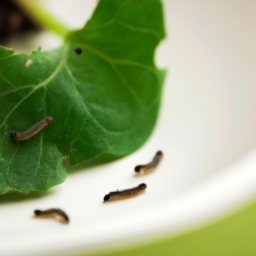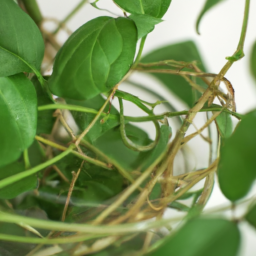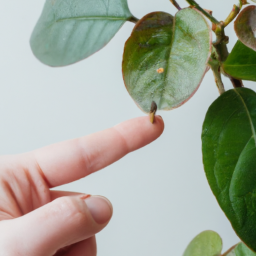
Have you ever wondered, “Will indoor plants get worms?” It’s a common concern among plant enthusiasts, as pests can wreak havoc on our beloved greenery. In this blog post, we’ll explore the likelihood of indoor plants getting worms, how to prevent infestations, and what to do if you suspect your plants are affected. So sit back, relax, and let’s dive into the fascinating world of indoor plant care.
How to Prevent Indoor Plants from Getting Worms
Understanding the Risk of Worms in Indoor Plants
As an expert in indoor plant care, I can assure you that indoor plants can indeed get worms if proper precautions are not taken. There are various types of worms that can infest indoor plants, such as root knot nematodes, fungus gnat larvae, and caterpillars. These worms can cause damage to the roots, leaves, and overall health of your plants if left untreated.
Worms can enter indoor plants through contaminated soil, infected plant material, or even through open windows and doors. Once inside, they can multiply quickly and wreak havoc on your beloved plants. It is important to be proactive in preventing worms from infesting your indoor plants to ensure their health and longevity.
By following a few simple steps, you can greatly reduce the risk of worms infesting your indoor plants and keep them thriving for years to come.
Tips for Preventing Worms in Indoor Plants
1. Use high-quality potting soil: Start by using a reputable brand of potting soil that is free from pests and diseases. Avoid using soil from your garden or unknown sources, as this can introduce worms and other pests to your indoor plants.
2. Inspect plants before bringing them indoors: Before bringing any new plants into your home, thoroughly inspect them for signs of pests or diseases. Look for wilting leaves, yellowing foliage, or any unusual spots or holes that could indicate a worm infestation.
3. Quarantine new plants: If you suspect that a new plant may be infested with worms, quarantine it away from your other indoor plants until you can treat it properly. This will prevent the spread of worms to your other plants and give you time to address the issue.
4. Maintain proper watering and drainage: Overwatering can create a damp environment that is ideal for worms to thrive in. Be sure to water your indoor plants only when the top inch of soil is dry, and ensure that your pots have proper drainage to prevent waterlogged conditions.
5. Keep your plants clean: Regularly dusting off the leaves of your indoor plants can help prevent the buildup of debris that can attract worms and other pests. Wiping down the leaves with a damp cloth can also help remove any eggs or larvae that may be present.
6. Monitor plant health: Keep a close eye on the health of your indoor plants and watch for any signs of distress, such as wilting, yellowing, or stunted growth. Addressing any issues promptly can help prevent worms from taking hold and causing further damage.
Treating Worm Infestations in Indoor Plants
If you suspect that your indoor plants have been infested with worms, there are several treatment options available to help eradicate the pests and restore your plants to health. Some common methods for treating worm infestations in indoor plants include:
1. Neem oil: Neem oil is a natural insecticide that can help control a variety of pests, including worms. Dilute the neem oil according to the manufacturer’s instructions and spray it on the affected plants to kill the worms and prevent further infestations.
2. Beneficial nematodes: Beneficial nematodes are microscopic worms that can help control pest populations in the soil, including root knot nematodes. Simply mix the beneficial nematodes with water and apply them to the soil of your infested plants to reduce the worm population.
3. Manual removal: For larger worms, such as caterpillars, you can manually remove them from your plants by picking them off or using a gentle spray of water to dislodge them. Be sure to dispose of the worms in a sealed bag to prevent them from returning to your plants.
By following these tips for preventing and treating worm infestations in indoor plants, you can keep your plants healthy and thriving year-round. Remember to stay vigilant and proactive in your plant care routine to ensure that worms stay far away from your indoor oasis.

Common Signs of Worm Infestation in Indoor Plants
As an expert in indoor plant care, I can tell you that dealing with worm infestations in indoor plants can be a real challenge. Worms can cause damage to the roots of your plants, leading to stunted growth and even death if left untreated. In this guide, I will walk you through the common signs of worm infestation in indoor plants so that you can take action before it’s too late.
Yellowing or Wilting Leaves
One of the most common signs of worm infestation in indoor plants is yellowing or wilting leaves. If you notice that the leaves of your plant are turning yellow or wilting, it could be a sign that worms are feeding on the roots of the plant. This is because worms feed on the nutrients in the soil, depriving the plant of essential nutrients it needs to thrive. If left untreated, the plant may eventually die.
To check for worm infestation, gently remove the plant from its pot and inspect the roots. If you see small, white worms crawling around the roots, it’s a clear sign that your plant has a worm infestation. In this case, you will need to take action to remove the worms and treat the plant to prevent further damage.
To treat a worm infestation, you can use a natural insecticide or pesticide specifically designed to target worms. Make sure to follow the instructions on the product label carefully to ensure the safety of your plant. You may also need to repot the plant in fresh, worm-free soil to prevent reinfestation.
Sudden Decline in Plant Health
Another common sign of worm infestation in indoor plants is a sudden decline in plant health. If you notice that your plant is not growing as vigorously as it used to, or if it is producing fewer flowers or fruits, it could be a sign that worms are present in the soil. Worms can cause damage to the roots of the plant, leading to nutrient deficiencies and poor overall health.
In addition to yellowing or wilting leaves, other signs of worm infestation include stunted growth, leaf drop, and a general lack of vitality in the plant. If you notice any of these symptoms, it’s important to take action quickly to prevent further damage to the plant.
To prevent worm infestations in indoor plants, make sure to use high-quality potting soil that is free from pests and diseases. Avoid overwatering your plants, as this can create a moist environment that is conducive to worm infestations. Regularly inspect your plants for signs of pests or diseases, and take action immediately if you notice any unusual symptoms.
Visible Worms in the Soil
If you see small, white worms crawling around in the soil of your indoor plant, it’s a clear sign that your plant has a worm infestation. These worms are likely feeding on the roots of the plant, depriving it of essential nutrients and causing damage to its overall health. If left untreated, the plant may eventually die.
To get rid of worms in the soil, you can try manually removing them with a pair of tweezers or a small shovel. Make sure to remove as many worms as possible, as even a few worms can cause significant damage to the plant. You can also use a natural insecticide or pesticide to kill off any remaining worms in the soil.
After treating the plant for worms, make sure to monitor its progress closely to ensure that the infestation does not return. Regularly inspect the plant for signs of pests or diseases, and take action immediately if you notice any unusual symptoms. With proper care and attention, you can prevent worm infestations in your indoor plants and keep them healthy and thriving.

Effective Treatment Methods for Worms in Indoor Plants
Understanding the Problem
When it comes to indoor plants, dealing with worms can be a common issue that many plant owners face. These pests can wreak havoc on your plants, causing damage to the roots and leaves, and ultimately leading to the decline of your plant’s health. It’s important to be able to identify the signs of a worm infestation in your indoor plants so that you can take action quickly to prevent further damage.
One of the most common signs of a worm infestation in indoor plants is the presence of small holes in the leaves. These holes are typically caused by the worms feeding on the plant’s foliage. You may also notice a sticky substance on the leaves, which is a byproduct of the worms feeding on the plant. Additionally, you may see small, white worms crawling on the surface of the soil or around the base of the plant.
Treating the Infestation
Once you have identified a worm infestation in your indoor plants, it’s important to take action to treat the problem effectively. There are several treatment methods that you can use to get rid of worms in your plants and prevent further damage.
One effective treatment method is to manually remove the worms from the plant. You can do this by carefully inspecting the plant and picking off any worms that you see. Make sure to dispose of the worms in a sealed bag or container to prevent them from spreading to other plants.
Another treatment method is to use a natural insecticide to kill the worms. There are many natural insecticides available that are safe to use on indoor plants and can effectively eliminate worms. Be sure to follow the instructions on the insecticide label and apply it to the plant as directed.
Additionally, you can try using beneficial nematodes to control the worm population in your indoor plants. Beneficial nematodes are microscopic organisms that feed on worms and can help to reduce the infestation in your plants. You can purchase beneficial nematodes at your local garden center and apply them to the soil according to the instructions.
Preventing Future Infestations
To prevent future worm infestations in your indoor plants, it’s important to practice good plant care habits. Make sure to regularly inspect your plants for signs of pests and treat any issues promptly. Keep your plants well-watered and fertilized, as healthy plants are less likely to attract pests.
You can also consider using preventive measures, such as placing sticky traps around your plants to catch any pests that may be present. Additionally, you can introduce beneficial insects, such as ladybugs, to help control pest populations in your indoor plants.
By following these effective treatment methods and taking steps to prevent future infestations, you can keep your indoor plants healthy and pest-free. Remember to regularly monitor your plants for signs of pests and take action quickly if you notice any issues. With proper care and attention, you can enjoy beautiful, thriving indoor plants free from worms.
I’ll leave you with these final thoughts
Indoor plants are a popular way to bring a touch of nature into our homes, but many people worry about the possibility of their plants getting worms. The good news is that indoor plants are unlikely to get worms in the traditional sense. While outdoor plants can sometimes attract worms that live in the soil, indoor plants are typically grown in potting mix that is free of these pests.
However, indoor plants can still face their own set of challenges, such as fungus gnats or root rot. Fungus gnats are tiny flies that lay their eggs in the soil of houseplants, and their larvae can feed on plant roots. To prevent fungus gnats, make sure to let the soil dry out between waterings and avoid overwatering your plants. Root rot, on the other hand, occurs when a plant’s roots are constantly sitting in water, leading to decay and eventual death of the plant. To prevent root rot, make sure your plant’s pot has proper drainage and only water when the top inch of soil is dry. So while indoor plants may not get worms, it’s still important to keep an eye out for other potential pests and issues to keep your plants healthy and thriving.
Top FAQs:
Q1. Can indoor plants get worms?
A1. Indoor plants are unlikely to get worms as they are typically found in outdoor soil. However, indoor plants can sometimes attract pests like fungus gnats or spider mites.
Q2. How do worms affect indoor plants?
A2. Worms themselves do not typically affect indoor plants. In fact, worms can be beneficial for outdoor plants by aerating the soil and breaking down organic matter.
Q3. What should I do if I find worms in my indoor plant soil?
A3. If you find worms in your indoor plant soil, it is best to remove them and ensure that your plant is not overwatered, as this can attract pests like fungus gnats.
Q4. How can I prevent worms from getting into my indoor plants?
A4. To prevent worms from getting into your indoor plants, make sure to use high-quality potting soil that is free from pests. Avoid overwatering your plants, as this can create a hospitable environment for pests.
Q5. Are there any natural remedies to get rid of worms in indoor plant soil?
A5. One natural remedy to get rid of worms in indoor plant soil is to sprinkle diatomaceous earth on the soil surface. This can help to deter pests like worms without harming your plants.

James Wong is a renowned ethnobotanist, plant scientist, and local television presenter. With a passion for demystifying plant science, he is known for translating complex botanical concepts into practical advice for everyday plant enthusiasts. James’s expertise spans from traditional gardening to cutting-edge plant technologies, making his insights accessible and informative.


